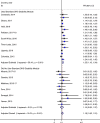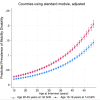Adolescent childbirth and mobility disability among women ages 15-49: an analysis of population health surveys from 14 low-income and middle-income countries
- PMID: 37474178
- PMCID: PMC10360427
- DOI: 10.1136/bmjopen-2023-072535
Adolescent childbirth and mobility disability among women ages 15-49: an analysis of population health surveys from 14 low-income and middle-income countries
Abstract
Objectives: Adolescent childbirth is associated with older adult adverse health outcomes that negatively affect mobility function, but these associations have not been studied globally in large samples of reproductive-age women. This study examines the association between age at first childbirth and mobility disability in national surveys from low-income and middle-income countries, and hypotheses that adolescent childbirth is associated with mobility disability.
Design: Cross-sectional analysis.
Setting: Population health surveys from 2013 to 2018 containing mobility disability measures among ever-pregnant women ages 15-49. These included 13 Demographic Health Surveys from Haiti, Pakistan, Uganda, Cambodia, Colombia, South Africa, Timor-Leste, Albania, Gambia, Maldives, Peru, Senegal and Yemen and 1 Maternal Health Survey from Ghana.
Participants: The sample included 157 988 women ages 15-49 years.
Primary outcome measure: Adolescent childbirth was defined as 10-19 years of age. Poisson regression models were used to estimate prevalence ratios (PRs) of mobility disability among women who first gave birth during adolescence and in adult life (ages 20-45 years) in each country and across the whole sample. Countries were also analysed according to the use of standard and non-standard mobility disability measures. Covariates included current age, urban/rural residence, education and household wealth.
Results: Prevalence of adolescent childbirth (17.5%-66.2%) and mobility disability (0.32%-21.45%) varied widely across countries. Adolescent childbirth was significantly (p<0.05) associated with greater mobility disability in six of eight countries using standard disability measures. Among the six countries that did not use standard disability measures, none showed a statistically significant association between adolescent childbirth and mobility disability. Considering the whole sample and adjusting for all covariates, women who gave birth during adolescence had greater prevalence of mobility disability (pooled PR 1.19, 95% CI 1.06-1.31).
Conclusions: This analysis suggests a moderate and consistent association of adolescent childbearing with subsequent mobility disability.
Keywords: EPIDEMIOLOGIC STUDIES; Epidemiology; Public health.
© Author(s) (or their employer(s)) 2023. Re-use permitted under CC BY-NC. No commercial re-use. See rights and permissions. Published by BMJ.
Conflict of interest statement
Competing interests: None declared.
Figures


Similar articles
-
Prevalence of Body Mass Index Lower Than 16 Among Women in Low- and Middle-Income Countries.JAMA. 2015 Nov 24;314(20):2164-71. doi: 10.1001/jama.2015.15666. JAMA. 2015. PMID: 26599184
-
Factors associated with non-utilisation of health service for childbirth in Timor-Leste: evidence from the 2009-2010 Demographic and Health Survey.BMC Int Health Hum Rights. 2014 May 5;14:14. doi: 10.1186/1472-698X-14-14. BMC Int Health Hum Rights. 2014. PMID: 24885424 Free PMC article.
-
Trends and determinants of adolescent childbirth in Uganda- analysis of rural and urban women using six demographic and health surveys, 1988-2016.Reprod Health. 2020 May 26;17(1):74. doi: 10.1186/s12978-020-00925-8. Reprod Health. 2020. PMID: 32456705 Free PMC article.
-
Factors associated with health facility utilization during childbirth among 15 to 49-year-old women in Uganda: evidence from the Uganda demographic health survey 2016.BMC Health Serv Res. 2021 Oct 26;21(1):1160. doi: 10.1186/s12913-021-07179-5. BMC Health Serv Res. 2021. PMID: 34702251 Free PMC article.
-
Nutritional interventions for preventing stunting in children (birth to 59 months) living in urban slums in low- and middle-income countries (LMIC).Cochrane Database Syst Rev. 2019 Jun 17;6(6):CD011695. doi: 10.1002/14651858.CD011695.pub2. Cochrane Database Syst Rev. 2019. PMID: 31204795 Free PMC article.
Cited by
-
The contributions of fertility during adolescence to disability across the life-course: hypothesized causal pathways, research gaps, and future directions.Ann Hum Biol. 2024 Feb;51(1):2390829. doi: 10.1080/03014460.2024.2390829. Epub 2024 Aug 29. Ann Hum Biol. 2024. PMID: 39206847 Free PMC article. Review.
-
Pregnancy is linked to faster epigenetic aging in young women.Proc Natl Acad Sci U S A. 2024 Apr 16;121(16):e2317290121. doi: 10.1073/pnas.2317290121. Epub 2024 Apr 8. Proc Natl Acad Sci U S A. 2024. PMID: 38588424 Free PMC article.
References
-
- World Health Organization . World report on disability; 2011. Available: https://www.who.int/publications-detail-redirect/9789241564182 [Accessed 1 May 2023]. - PubMed
-
- World Health Assembly 58 . Disability, including prevention, management and rehabilitation. World Health Organization; 2005. Available: https://apps.who.int/iris/handle/10665/20373 [Accessed 1 May 2023].
Publication types
MeSH terms
Grants and funding
LinkOut - more resources
Full Text Sources
Research Materials
